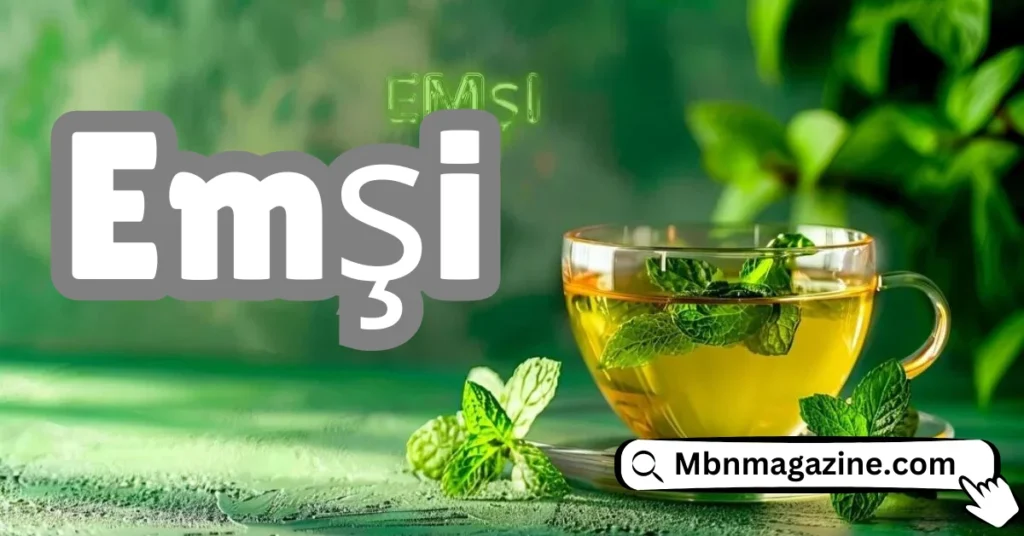Introduction
Emşi is a period that carries wealthy cultural and historical connotations, varying extensively in importance depending on the context. In a few regions, It can also give a traditional dish that is deeply embedded in nearby cuisines, while in others, it can indicate a historical figure or practice with symbolic significance. This article aims to shed light on its multifaceted nature, exploring its origins, cultural significance, and its function in modern society. Understanding Emşi offers a window into the numerous traditions and practices that form one-of-a-kind cultures, highlighting the methods wherein history and identity are preserved and celebrated.
Origins and Historical Background

The origins of Emşi are deeply rooted in the cultural and ancient tapestry of the regions where it’s far located. The term “Emşi” can also have special meanings and institutions based on the unique geographical and cultural context. Uncovering its ancient heritage entails exploring the nearby traditions, practices, and ancient narratives that have shaped its significance. In some contexts, It may refer to a traditional culinary item, including a selected type of dish or method of practice that has been passed down through the generations. These dishes regularly mirror the rural practices, seasonal elements, and culinary techniques of a particular vicinity. Historical information, oral traditions, and neighborhood cookbooks can offer insights into how these recipes developed over the years and became indispensable to cultural celebrations and daily life. Alternatively, It may represent a historical figure or practice. In this situation, its origins are probably traced lower back to great occasions, social structures, or influential personalities in records. Historical documents, folklore, and cultural research can help find the position and effect of Emşi in shaping local customs and traditions. Its evolution often reflects broader ancient changes, including migration, trade, or colonization. These elements may contribute to its fusion or edition, combining traditional elements with new influences and developing a unique cultural pattern. By examining its ancient context, we gain a deeper knowledge of its origins and how it has been preserved and changed over the years. This exploration highlights the interconnectedness of cultural practices and ancient tendencies, presenting a richer appreciation of Emşi’s sig
Cultural Significance

It occupies a special place in the cultural tapestry of the communities to which it belongs. Its importance frequently extends past mere lifestyle, reflecting deeper values, social norms, and communal bonds.
- Symbolic Meaning: In many cultures, It is not just a culinary delight or an antique. It has symbolic meanings that represent elements of identity, history, and continuity. For example, traditional dishes like Emşi are probably associated with particular rituals or celebrations, serving as a way to connect generations and enhance cultural identification.
- Social Practices: Its practice and use regularly serve a function in social gatherings and events. It is probably featured prominently in the course of gala’s, circle of relatives reunions, or other massive occasions. These occasions provide opportunities for people to come back collectively, proportion memories, and have fun with their history. The process of developing it can also be a way of passing down skills and traditions from an era.
- Cultural Preservation: It serves as a living hyperlink to the beyond, preserving cultural practices and ancient narratives. In a few communities, efforts to file and promote Emşi reflect a broader commitment to safeguarding cultural and historical past. By continuing to make and rejoice Emşi, people keep their traditions vibrant and relevant, making sure that they’re not misplaced to time.
- Community Identity: It can also play a role in defining community identity. For many, it represents a shared enjoyment and a connection to a collective past. It can foster a feeling of belonging and satisfaction, reinforcing communal ties and cultural continuity. In summary, It is much more than a simple lifestyle or pattern. It is a cornerstone of cultural expression that holds deep significance.
Contemporary Relevance

In nowadays’s unexpectedly converting world, the relevance of traditions like Emşi is both complex and crucial. As globalization and modernization transform life and cultural practices, the preservation of nearby customs and backgrounds becomes more and more critical. Emşi, whether it’s for a culinary lifestyle, a historical artifact, or a cultural exercise, faces both opportunities and demanding situations in the modern-day era.
1. Cultural Preservation and Revival: Efforts to report, maintain, and revive Emşi replicate a broader movement to hold cultural background. Organizations, local groups, and cultural advocates work to guard conventional practices, ensuring that they are passed down to future generations. This involves creating files, sharing recipes, and organizing activities that commemorate Emşi and its significance.
2. Globalization and Cultural Exchange: Globalization brings extended exposure to various cultures, that may result in both the dilution and enrichment of traditional practices. It will likely benefit from recognition of its origins, resulting in a transcultural exchange in which a variety of groups appropriate and adapt these traditions. This can foster greater appreciation and understanding however also raises questions about cultural appropriation and authenticity.
3. Economic and Tourism Opportunities: Cultural traditions like Emşi can grow to be valuable property for local economies. Culinary traditions and ancient practices attract travelers, contributing to nearby agencies and selling economic improvement. For example, galas and the food activities they offer can draw traffic and create opportunities for cultural education and alternatives.
4. Identity and Community Building: In a technology wherein cultural identification can be increasingly fragmented, It serves as a touchstone for networking brotherly love and happiness. Engaging with conventional practices fosters an experience of belonging and continuity, helping people hook up with their heritage and fortify community bonds. This is especially massive for more youthful generations who may also be seeking to apprehend and include their cultural roots.
5. Digital and Media Influence: The upward thrust of digital media gives new platforms for sharing and celebrating Emşi. Social media, blogs, and online communities provide areas for people to discover, talk, and sell traditional practices. This digital presence enables improved focus and might encourage hobbies in Emşi among an international audience.
In precis, the modern-day relevance of Emşi underscores its function as a residing way of life that adapts to fashionable contexts whilst retaining its essence. Navigating the demanding situations of globalization and embracing new possibilities, complements the cultural landscape and improves inter-generational connections.
Conclusion
Emşi represents greater than only a period; it’s far a testament to the wealthy tapestry of cultural and historic traditions that define various groups. Whether it denotes a conventional dish, a historic exercise, or a symbolic figure, It encapsulates the essence of local history and communal identity. By inspecting its origins and importance, we benefit from a deeper appreciation for the values and customs that have been handed down through generations. In our increasingly interconnected international, preserving and celebrating traditions like Emşi is essential for preserving cultural range and continuity. It no longer most effectively connects us beyond it, but also reinforces our influence.
FAQS
1. What is Emşi?
Emşi can refer to various things depending on the cultural or regional context. It is probably a conventional dish, a historic figure, or a cultural exercise. The genuine means of Emşi varies and is frequently tied to particular local traditions and histories.
2. What are the origins of Emşi?
The origins of Emşi rely upon its unique context. For a dish, it may have roots in local agricultural practices and historic recipes. For an ancient parent or practice, its origins would be tied to the cultural and historical trends of the region.
3. How is Emşi traditionally prepared or practiced?
If Emşi is a dish, its education might involve unique elements and methods specific to the place. If it’s a cultural practice, it can contain rituals, ceremonies, or customs that have been handed down through generations.
4. Why is Emşi massive in its cultural context?
Emşi often holds cultural importance because it represents history, culture, and identity. It can be significant to celebrations, ceremonies, or day-by-day lifestyles, reflecting the values and history of the network.
5. How has Emşi developed over the years?
Emşi may have evolved because of changes in society, technology, and cultural trade. Modern effects and worldwide interactions can impact how Emşi is practiced or perceived, mainly to diversification at the same time as retaining its middle significance.
6. What efforts are being made to keep Emşi?
Preservation efforts may also consist of documenting traditional recipes, undertaking studies, and promoting attention thru cultural activities and educational programs. These efforts help make certain that Emşi stays a residing part of cultural heritage.
7. Where can I research extra approximately Emşi?
To research more about Emşi, do not forget to explore nearby historical information, and cultural research, or entice community participants who exercise or have an understanding of Emşi. Museums, cultural centers, and academic research also can provide precious insights.



